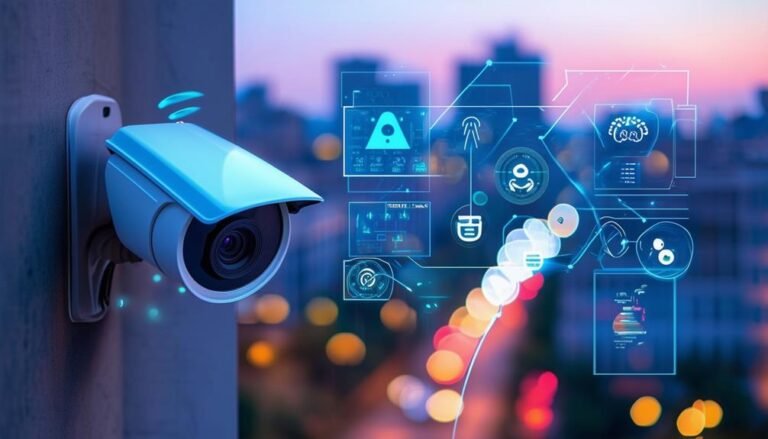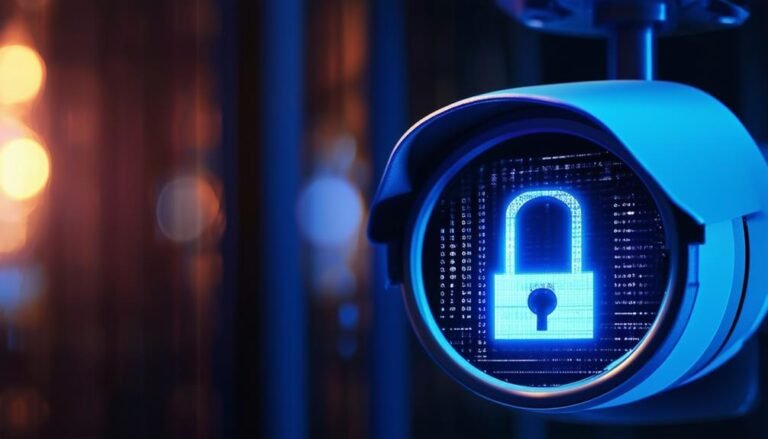To reset your Dahua IP camera, first unplug it and wait about 10-15 seconds. For a soft reset, simply reconnect the power and allow it to reboot. If you need a hard reset, locate the small reset button, press and hold it with a pin while powering the camera back on, and hold it until the LED flashes. Alternatively, use the web interface by logging in and directing yourself to the “Configuration” tab to find the reset option. This process can help address connectivity issues and restore your camera to factory settings. There’s a lot more you can explore to optimize your camera’s performance.
Reasons to Reset Your Camera
There are several reasons you might need to reset your Dahua IP camera. One of the most common reasons is if you’re experiencing connectivity issues. Sometimes, the camera just won’t connect to your network, leaving you feeling frustrated. A reset can help clear up any glitches and restore that crucial connection, allowing you to regain control and peace of mind.
Another reason to think about a reset is if you’re changing your network settings or moving to a new location. This might involve switching from one Wi-Fi network to another, and the camera won’t automatically adapt to these changes. By resetting it, you can start fresh and guarantee it’s set up correctly in its new environment.
Security is also a significant factor. If you’ve recently purchased a used camera, it’s important to reset it to remove any old settings that might compromise your privacy. A reset guarantees that you’re the only one with access, promoting a sense of freedom and control over your surveillance.
Lastly, if you’re looking to restore the camera to its original factory settings, a reset is the way to go. This can be especially helpful if you’ve made numerous adjustments and want to start from scratch.
In all these cases, having the ability to reset your Dahua IP camera empowers you to maintain a secure, efficient, and flexible surveillance system, giving you the freedom to monitor your property how you see fit.
Preparing for the Reset
Before you proceed with resetting your Dahua IP camera, it’s vital to prepare properly to avoid any complications. First, verify you have access to the camera’s power source and network. A reliable power supply is fundamental, as interruptions during the reset process can lead to further issues. If possible, unplug the camera and plug it back in to check if it powers up without any problems.
Next, gather the necessary tools for the reset. A small pin or paperclip is often required for hard resets, so keep one handy. You’ll also want to have your camera’s manual nearby, as it can provide specific instructions tailored to your model. Familiarize yourself with the reset procedures outlined in the manual so you know what to expect.
It’s also a good idea to back up any important settings or configurations before you reset. If your camera is part of a larger security system, make sure you know how to restore your settings afterward. Jot down any custom settings you’ve configured, as these may be lost during the reset process.
Lastly, inform anyone who uses the camera about the reset. This way, they won’t be caught off guard if the camera becomes temporarily non-functional. By taking these steps, you’ll set yourself up for a smoother reset process and maintain control over your security setup.
Soft Reset Procedure
If you’re looking to troubleshoot minor issues or refresh your Dahua IP camera without losing any settings, a soft reset is a great option. This procedure can help restore normal functionality while keeping your configurations intact. Here’s how to perform a soft reset effectively.
Soft Reset Steps
- Locate the Power Source: Unplug the power cable from your Dahua IP camera.
- Wait a Moment: Allow the camera to remain off for about 10-15 seconds. This helps clear temporary configurations that might be causing issues.
- Reconnect the Power: Plug the power cable back in.
- Wait for Reboot: Allow the camera to fully reboot, which may take a couple of minutes.
To give you a clear overview, here’s a simple table that summarizes the soft reset procedure:
| Step | Action |
|---|---|
| 1 | Unplug the power cable |
| 2 | Wait for 10-15 seconds |
| 3 | Plug the power cable back in |
Once your camera has rebooted, check to see if the issues have been resolved. If everything’s working smoothly, you’ve successfully performed a soft reset. This process is straightforward and can save you a lot of hassle when dealing with minor glitches. Remember, a soft reset is your go-to solution for quick fixes without sacrificing your settings. Enjoy the freedom of a well-functioning camera!
Hard Reset Procedure
When you need to resolve persistent issues that a soft reset can’t fix, a hard reset is your next step. This procedure wipes all settings, returning your Dahua IP camera to its factory defaults. While it may sound intimidating, it’s a straightforward process that can breathe new life into your device.
To perform a hard reset, follow these steps:
- Power off the camera: Unplug the power source to guarantee it’s completely off before starting.
- Locate the reset button: This is usually found on the back or bottom of the camera. It might be a small pinhole.
- Press and hold: Use a pin or a paperclip to press the reset button and hold it down.
- Power on the camera: While still holding the reset button, plug the camera back in.
- Wait for the reset: Continue holding the button for about 10-15 seconds, until you see the LED indicators flash, signaling the reset is complete.
Once you’ve completed the hard reset, you’ll need to reconfigure your settings, including your network information and any custom configurations. Remember, doing a hard reset can provide a fresh start, allowing you to set up your camera like new. Embrace the freedom that comes with a clean slate and enjoy the enhanced functionality of your Dahua IP camera!
Resetting via Web Interface
Resetting your Dahua IP camera via the web interface offers a convenient way to restore factory settings without needing physical access to the device. This means you can regain control and guarantee your camera’s functionality with just a few clicks. Here’s how to do it:
- Open your web browser and enter the camera’s IP address.
- Log in using your credentials. If you haven’t changed them, they’re likely set to default.
- Navigate to the “Configuration” tab.
- Look for the “System” settings, then find the “Restore” or “Reset” option.
- Click on “Factory Default” and confirm your choice.
This method grants you the freedom to manage your camera remotely, making it easier to maintain your security system without being tied down to physical access.
| Step | Action | Note |
|---|---|---|
| 1 | Open web browser | Guarantee you’re connected to the network |
| 2 | Enter camera IP | Default is often 192.168.1.108 |
| 3 | Log in | Use default credentials if unmodified |
| 4 | Navigate to Configuration | This is usually on the main menu |
| 5 | Select Factory Default | Confirm to complete the reset |
Troubleshooting After Reset
What should you do if your Dahua IP camera isn’t functioning properly after a reset? First off, don’t panic—this is a common issue, and there are several steps you can take to troubleshoot the situation. Start by checking the basics. Verify your camera is powered on and connected properly to your network. Sometimes, it’s the simplest things that cause the biggest headaches.
Here’s a quick checklist to help you troubleshoot:
- Verify Power Supply: Check that the camera is receiving adequate power and that all cables are securely connected.
- Check Network Connection: Make sure the camera is connected to your network, either through Ethernet or Wi-Fi.
- Inspect IP Settings: Verify that the camera is set to the correct IP address and subnet mask for your network.
- Update Firmware: Sometimes, resetting the camera can lead to out-of-date firmware. Check the manufacturer’s website for updates.
- Review Firewall Settings: Verify your firewall or security settings aren’t blocking the camera’s access to the network.
If you’ve gone through these steps and your camera still isn’t working, you might want to consult the user manual or reach out to Dahua support for additional assistance. Remember, troubleshooting can take time, but don’t lose hope. Stay persistent, and you’ll likely find the solution you need to get your camera back up and running smoothly.
Reconfiguring Your Camera
After troubleshooting issues post-reset, it’s time to reconfigure your Dahua IP camera to confirm it operates at its best. Begin by accessing the camera’s web interface. You can do this by entering the camera’s IP address into your web browser. If you don’t know the IP, use the Dahua IP Tool to discover it. Once you’ve logged in with your credentials, you can start customizing your camera settings.
First, adjust your camera’s network settings. Set a static IP address to maintain a consistent connection, guaranteeing that your camera is always accessible. Next, configure the video settings. Choose the resolution and frame rate that suit your monitoring needs, balancing quality with bandwidth usage.
Don’t forget to set up motion detection and alerts. This feature can help you stay informed about activity in your monitored area, enhancing your sense of security. You can also set up scheduled recordings, allowing you to capture footage when you need it most without constantly recording.
Additionally, if you’ve got multiple cameras, consider grouping them for easier management. This way, you can monitor all feeds from a single interface, promoting a seamless experience.
Lastly, remember to save your settings. It’s essential to test the camera after reconfiguration to verify everything is working correctly. With these adjustments, you’ll regain control and peace of mind, allowing your Dahua IP camera to serve you effectively in your pursuit of security.
Preventative Measures for Future Issues
To prevent future issues with your Dahua IP camera, maintaining regular software updates is essential. Staying current with updates not only enhances security but also improves functionality and compatibility. You don’t want to miss out on the latest features or fixes that could protect your camera from vulnerabilities. Beyond software, there are several additional steps you can take to guarantee your camera operates smoothly over time.
- Regularly Check Camera Settings: Periodically review your camera settings to guarantee they align with your current needs.
- Secure Your Network: Use strong passwords and encryption to safeguard your network from unauthorized access.
- Monitor Storage Space: Keep an eye on your storage capacity; running out of space can lead to missed recordings.
- Clean the Camera Lens: Dust and debris can obstruct the view, so make it a habit to clean the lens regularly.
- Create Backup Configurations: Save your camera settings periodically. This way, if something goes wrong, you can quickly restore your preferred configuration.
Frequently Asked Questions
What Are the Benefits of Resetting a Dahua IP Camera?
Resetting a Dahua IP camera can offer you several benefits. It helps clear any glitches or connectivity issues, restoring peak performance. You’ll regain access to the camera’s settings, allowing you to customize features according to your needs. Plus, if you’ve forgotten your login credentials, a reset can help you regain control. It’s a straightforward way to enhance security and guarantee your surveillance system functions smoothly, giving you peace of mind in your space.
Can Resetting My Camera Delete Recorded Footage?
Resetting your camera could lead to lost recorded footage, so you’ll want to tread carefully. If you’re seeking serenity, consider backing up your videos before hitting that reset button. This simple safeguard guarantees your precious memories aren’t accidentally erased. Cameras can be fickle, so it’s wise to weigh the pros and cons of a reset. Remember, freedom comes with foresight! Protect what you cherish as you navigate the nuances of your device.
How Often Should I Reset My Dahua IP Camera?
You should reset your Dahua IP camera whenever you’re experiencing connectivity issues or after a firmware update. If the camera starts acting up, a reset might help restore its functionality. Generally, it’s not necessary to reset it frequently; only do so when needed. Keeping your camera updated and maintaining a stable internet connection can minimize the need for resets. Trust your instincts—if it feels off, a reset could be the solution.
Is It Safe to Reset the Camera Remotely?
When it comes to resetting your camera remotely, it’s like playing with fire—you’ve got to be cautious. While it’s generally safe, make certain you’re connected to a secure network to avoid threats. Remote resets can save you time and hassle, but they might leave you vulnerable if not done properly. Always double-check your settings and be prepared for unexpected glitches. If in doubt, a manual reset might be the safer bet.
Will Resetting Affect My Camera’s Warranty?
Resetting your camera usually won’t void the warranty, but it’s best to check the specific terms. Most manufacturers allow resets as part of regular use. However, if you’ve tampered with the hardware or software in other ways, that might cause issues. To be safe, keep your receipts and document any changes. If in doubt, reach out to customer support for clarity on your warranty’s coverage regarding resets.



